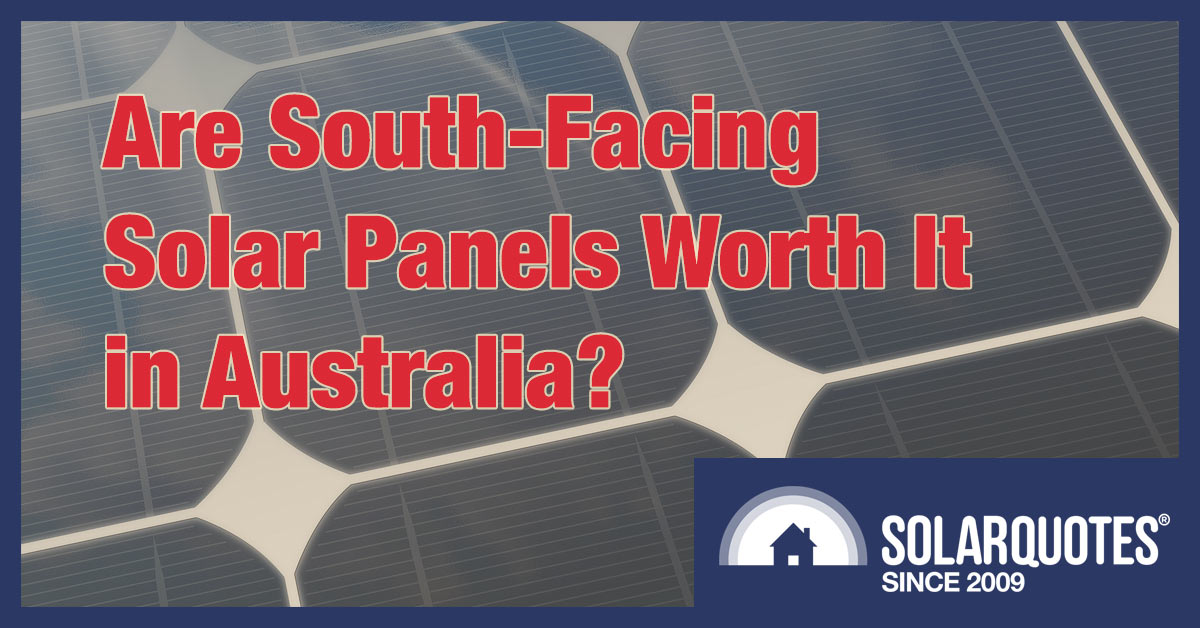
TLDR: Can you put solar panels facing south in Australia? Hell yeah!
In 2010, when Australian rooftop solar power really started to take off, nearly every Australian solar system faced north to maximise energy yield. But today, on an unshaded roof, panels facing any direction can pay for themselves. This includes the ‘worst’ direction: south.
In 2022, solar panels are over 80% cheaper than in 2010, and south-facing solar can be worthwhile. If your main goal is to maximise solar generation, that’s all you really need to know. You can stop reading and cover your entire roof with solar panels.
But you may prefer to weigh up the pros and cons before investing your hard-earned cash especially as there are still a few installers and salespeople who laugh at the mere thought of south-facing solar panels.
This article will give information on south-facing solar and explain why most homeowners are likely to find it a good investment. If you’re not interested in technical details and want to know how long it will take to pay for itself, skip down to the subheading, “Can South-Facing Panels Pay?”
3 Features Of South-Facing Solar
A few important factors affecting the output of south-facing solar are…
- Location: The further south you go, the less energy you’ll get from south-facing solar panels. Darwin is a better location for south-facing solar than Hobart.
- Tilt: The more gentle the slope of your roof, the more energy south-facing panels will generate. An unusually steep south-facing roof will decimate your energy yield.1
- Low Winter Output: In most capitals, the winter output of south-facing solar panels is under half of what north-facing panels would produce.
Location
The output of south-facing panels is affected by local climate, so the decline in their relative output compared to north-facing ones doesn’t occur smoothly. But if we compare Australia’s most northerly city with the most southerly one, the difference is clear. With a tilt of 15 degrees, the annual output of south-facing panels compared to otherwise identical north-facing ones in Darwin and Hobart will be:
- Darwin: Annual output of south-facing panels is 88% of north-facing ones
- Hobart: Annual output of south-facing panels is 74% of north-facing ones
The difference is mostly because the sun is higher in the sky the closer a location is to the equator, and Darwin is 3,400 km closer.
I’ve arranged Australian capitals in order from north to south in the graph below. It shows the average annual output of south-facing solar at a 15º tilt as a percentage of the average annual output of otherwise identical north facing north at the same tilt:
As you can see, the relative performance of south-facing panels declines the further south you go, but it’s not a smooth process. The annual output of south-facing panels is 80% of north-facing ones in Brisbane and Perth, despite Perth being 500 km further south. This is because Brisbane has cloudy summers, when south-facing panels have their highest output, while Perth summers are mostly clear and dry.
Tilt/Angle
The two most common roof tilts for Australian homes are 15 and 22.5 degrees.
The less steep the slope of your roof, the higher the annual output of south-facing panels will be. This is because panels on a south-facing roof are tilted in the opposite of the best direction. The greater their tilt, the further away from the optimal position they become. This effect also becomes worse the further south you go.
As the figure above shows, increasing the tilt of south-facing panels from 15 degrees to 22.5 causes a greater drop in output in Hobart than in Darwin.
Tilt & Output In Sydney
If I use Australia’s largest city — Sydney — as an example and make a graph of the annual output of 1 kilowatt of north-facing solar and an otherwise identical 1 kilowatt of south-facing solar, and show how the annual output changes with tilt, it looks like this:
The graph shows the output of north-facing panels in Sydney slowly increases with tilt until 32.5 degrees is reached. After this, it slowly declines. This is very different from south-facing panels, which drop in output with every degree tilt is increased.
On a steep south-facing roof in Sydney with a 45º slope, panels will only produce two-thirds the annual output they would on a south-facing roof with the much more common slope of 22.5 degrees.
Tilt Racks
Tilt racks put legs on your solar panels so you can install them on a south-facing roof but still face them north.
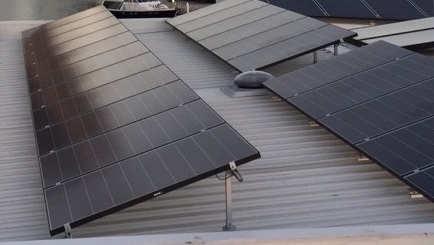
Here’s an example of the “legs” I’m referring to. You can decide for yourself whether or not they count as sexy.
If you have a flat roof, then tilt racks can be a good idea, but I don’t recommend them for angled roofs because:
- They’re not cheap.
- They can reduce the total number of panels that can fit on a roof section.
- Your local council may need to approve them.
Because solar panels cost far less than they used to, it usually makes more financial sense to install panels parallel with the roof than pay for tilt racks2.
Low Winter Output
Counter-intuitively, in some locations in summer, south-facing panels outperform north-facing ones at shallow roof angles. The graph below shows the average daily output in December for 1 kilowatt of solar PV in each capital. It compares one kilowatt of north-facing solar at 15 degrees tilt with 1 kilowatt of south-facing solar at 15 degrees tilt:
As the graph shows, the December output of south-facing panels is better than north-facing ones in Darwin, Brisbane, and Perth. In other capitals, there’s either little or no difference.
It’s a very different story in June, the worst month for solar generation in most locations. The graph below compares the average daily output in June for 1 kilowatt of north-facing solar at a 15º tilt with 1 kilowatt of south solar at a 15º tilt:
Compared to north-facing solar, south-facing winter solar generates two-thirds as much in Darwin, close to 60% in Brisbane, and under 50% in every other capital.
If your household uses more electricity for summer air conditioning than winter heating, then low winter output may not be a major problem. But in Canberra, Melbourne, and Hobart, more energy is used for winter heating than summer cooling, reducing the value of south-facing panels.
Information By Capital
Below I’ve given information on how direction affects solar generation in each capital. I’ve used compass roses like the ones below, giving information for Alice Springs:
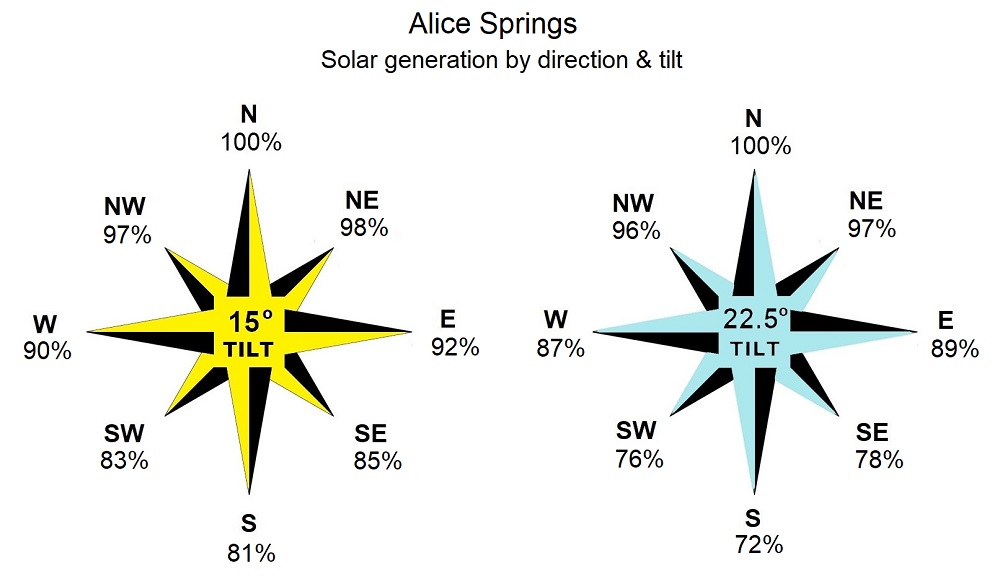
While Alice Springs is in the middle of Australia, solar there isn’t a middle of the road for Australian households. If there’s a capital closer to your location, information for it is likely to be a better guide.
The yellow compass rose is for panels tilted at 15 degrees, while the sort-of-blue one is for panels tilted at 22.5 degrees.
The percentage given for each of the eight compass directions is how much annual output panels facing that direction will produce compared to north-facing panels at that tilt.
I’ve provided percentages rather kilowatt-hour figures because — barring godlike powers — it’s not really possible to change how much sunlight a city receives. But it is possible to decide which section of roof to put solar panels on, so I decided percentages would be more useful.
I’ve also given annual and daily kilowatt-hour averages for north-facing panels in each capital. You can use the percentages to work them out for any direction if you wish.
Latitude is also provided, which indicates how far south of the equator a location is. Since most people who aren’t sailors aren’t very familiar with it, I’ve also given the figure for km from the equator for each capital.
Panels facing an easterly direction will produce more energy in the morning than in the afternoon, while panels facing a westerly direction are the opposite. Because households save more money by directly consuming solar energy rather than sending it into the grid for a feed-in tariff, the time a household consumes the most energy during the day is a consideration when deciding where to place solar panels.
Darwin
Darwin is Australia’s most northerly city with cloudy and wet summers, while winters are clear and dry. Despite frequent cloud cover during the Big Wet, Darwin solar has the highest average output of any capital. Because of its far north location, along with local climate, there’s no real difference between the annual output of solar at 15 degrees and 22.5 degrees.
- Latitude 12°26′ Distance from equator = 1,386 km
- 1 kw north facing solar average annual output: 15° tilt = 1691 kWh 22.5° tilt = 1691 kWh
- 1 kw north facing solar average daily output: 15° tilt = 4.63 kWh 22.5° tilt = 4.63 kWh
Brisbane
While not as extreme as Darwin, Brisbane also has most of its rain and cloud in summer, while winters are mostly clear and dry. It also has many birds that want to kill you.
- Latitude 27°28′ Distance from equator = 3,054 km
- 1 kw north facing solar average annual output: 15° tilt = 1,571 kWh 22.5° tilt = 1,599 kWh
- 1 kw north facing solar average daily output: 15° tilt = 4.30 kWh 22.5° tilt = 4.38 kWh
Perth
Clouds fear Perth, so solar generation is nearly as high as in Darwin over 2,000 km further north. Because only homes with solar power systems of 6.66 kilowatts or less can receive a feed-in tariff in WA, large systems are rare, and few homes have south-facing panels.
- Latitude 12°26′ Distance from equator = 3,553 km
- 1 kw north facing solar average annual output: 15° tilt = 1,655 kWh 22.5° tilt = 1,686 kWh
- 1 kw north facing solar average daily output: 15° tilt = 4.53 kWh 22.5° tilt = 4.62 kWh
Sydney
Sydney has no wet or dry season and is the even Steven of Australian capitals.
- Latitude 33°52′ Distance from equator = 3,766 km
- 1 kW north-facing solar average annual output: 15° tilt = 1,470 kWh 22.5° tilt = 1,509 kWh
- 1 kW north-facing solar average daily output: 15° tilt = 4.03 kWh 22.5° tilt = 4.13 kWh
Adelaide
Clear summer skies make annual solar generation in Adelaide only modestly lower than in Brisbane, despite being much further south.
- Latitude 34°56′ Distance from equator = 3,884 km
- 1 kw north facing solar average annual output: 15° tilt = 1,477 kWh 22.5° tilt = 1,513 kWh
- 1 kw north facing solar average daily output: 15° tilt = 4.05 kWh 22.5° tilt = 4.15 kWh
Canberra
Overall, solar output is high in Canberra. However, the winter output of south-facing panels is meagre, which is a pity because it can get damned cold there.
- Latitude 35°18′ Distance from equator = 3,923 km
- 1 kw north facing solar average annual output: 15° tilt = 1,482 kWh 22.5° tilt = 1,523 kWh
- 1 kw north facing solar average daily output: 15° tilt = 4.06 kWh 22.5° tilt = 4.17 kWh
Melbourne
Melbourne is the cloudiest capital on the mainland. The weather there has no idea what it’s doing from one hour to the next, but at least it’s not boring.
- Latitude 37°49′ Distance from equator = 4,205 km
- 1 kw north facing solar average annual output: 15° tilt = 1,329 kWh 22.5° tilt = 1,362 kWh
- 1 kw north facing solar average daily output: 15° tilt = 3.64 kWh 22.5° tilt = 3.73 kWh
Hobart
Hobart is Australia’s most southerly city and has the lowest solar output of any capital. Fortunately, not low enough to prevent solar power from being worthwhile.
- Latitude 42°53′ Distance from equator = 4,768 km
- 1 kw north facing solar average annual output: 15° tilt = 1,152 kWh 22.5° tilt = 1,142 kWh
- 1 kw north facing solar average daily output: 15° tilt = 3.16 kWh 22.5° tilt = 3.13 kWh
Can South Facing Panels Pay?
Yes. They can.
The easiest way to work out if south-facing solar is likely to pay is to use the SolarQuotes Solar & Battery Calculator. If you enter the relevant details, it will handle all the calculations and estimate a solar system’s simple payback time. This is how long it will take the savings on electricity bills to equal the cost of a solar power system.
What payback period is enough to make solar worthwhile is something people have to decide for themselves3, but I think the return from south-facing solar on a typical unshaded roof anywhere in Australia should be good enough to appeal to the majority of people who don’t owe money to the mafia.
Determining Payback Period
Our Solar & Battery Calculator lets you enter…
- The direction — or directions — your solar panels will face.
- The slope of the roof.
- The cost of grid electricity
- The solar feed-in tariff.
- The cost of the system.
- How much you spend on electricity per year.
- Whether or not you have a battery.
This is a considerable amount of information to input. Still, it automatically provides default values for a typical household, so if you’re happy with them, it makes things a lot faster.
To get an estimate of the simple payback time of south-facing solar in every capital, I’ll have to consider…
- System size
- Panel direction and tilt
- Cost
- Electricity prices, and…
- Solar feed-in tariffs
System Size: I’ll assume a system with 6.6 kilowatts of panel capacity will be installed. In some locations, this is the maximum homes with single-phase power can install.
Direction and tilt: The system will face directly south and tilted at 23 degrees. Few solar power systems have all their panels facing south, but I’m assuming a worst-case situation for direction.
Cost: I’ll assume the system costs $6,000. This won’t pay for the best panels or inverter available but can cover a system composed of reliable components from an installer who does quality work.
Electricity Prices: To get an accurate estimate of the payback period, you should enter what you expect to typically pay for electricity during the day with the electricity plan you will have after you get solar installed. It may be necessary to estimate the amount. I’ll use the default values for my estimate for each capital.
Solar feed-in tariff: I will use our Solar & Battery Calculator’s default value for solar feed-in tariffs. In every state except WA, the default assumes the feed-in tariff will decrease by 1 cent a year down to a minimum of 6 cents. Western Australia doesn’t have this automatic reduction because their feed-in tariff is already close to rock bottom. I expect solar feed-in tariffs will rise over the next couple of years as the world economy recovers, but — to err on the side of caution — I will use the default values with the automatic reduction.
Other factors: For everything else, I’ll leave the defaults as they are. This includes solar electricity self-consumption based on the size and panel position for a typical home.
After entering the details into the Solar & Battery Calculator, it gave me the following payback periods in years for each capital:
The longest simple payback for south-facing solar is 7.2 years in Hobart. This isn’t surprising, as that city has the lowest solar output in Australia, and south-facing panels perform poorly there. But, while its payback period is the longest, it’s still not a bad investment for many Tasmanians. The old rule of thumb for business was a payback period of 7 years for an investment was worthwhile. This is now out of date, as the period has become longer. Whether or not it’s worthwhile for a household will come down to individual preferences. If you know you’re likely to stay in a home for more than seven years, I’d say you have little to lose. Even if you leave before it has paid for itself, a good solar power system will add to your home’s value.
The second-longest payback period is in Melbourne at 6.4 years. This is partly due to the climate, but also thanks to low electricity prices. But there is a Victorian Solar Rebate of up to $1,400 currently available I did not include. With that, the payback period falls to 3.8 years.
Adelaide has the shortest payback period of any capital — if the Victorian rebate is ignored. While not a great location for south-facing solar, high electricity prices and feed-in tariffs allow rapid payback.
Not As Good As Other Directions — But Often Worthwhile
For various reasons, including simply having plenty of roof space in a better direction, south-facing solar won’t suit everyone. But whether your goal is to…
- Save the planet.
- Save money.
- Have plenty of solar generation, so you’re prepared for when you get a home battery, electric car, increase consumption or ditch your gas connection.
Then south-facing solar can make plenty of sense. If you have a suitable south-facing roof without significant shading and can install solar panels there without difficulty, then I say fill your roof with solar.
Footnotes
- Update 12th February 2020: Note that panels installed at less then 10 degrees tilt are at increased risk of not being adequately cleaned by rain and may require cleaning to maintain output. This can more than offset the benefit of having south facing panels at a low tilt. ↩
- This is especially true because the STCs that reduce the up-front cost of solar are based on total panel capacity. This means it typically makes more financial sense to increase the size of the system than use tilt racks to improve the output of panels. (I feel bad now as if I’d just told my brother how to exploit a bug to cheat in a computer game…) ↩
- People should aim not to chase the shortest payback period but install the system, which is the best investment overall. This is usually a system much larger than one which has the shortest payback time. ↩

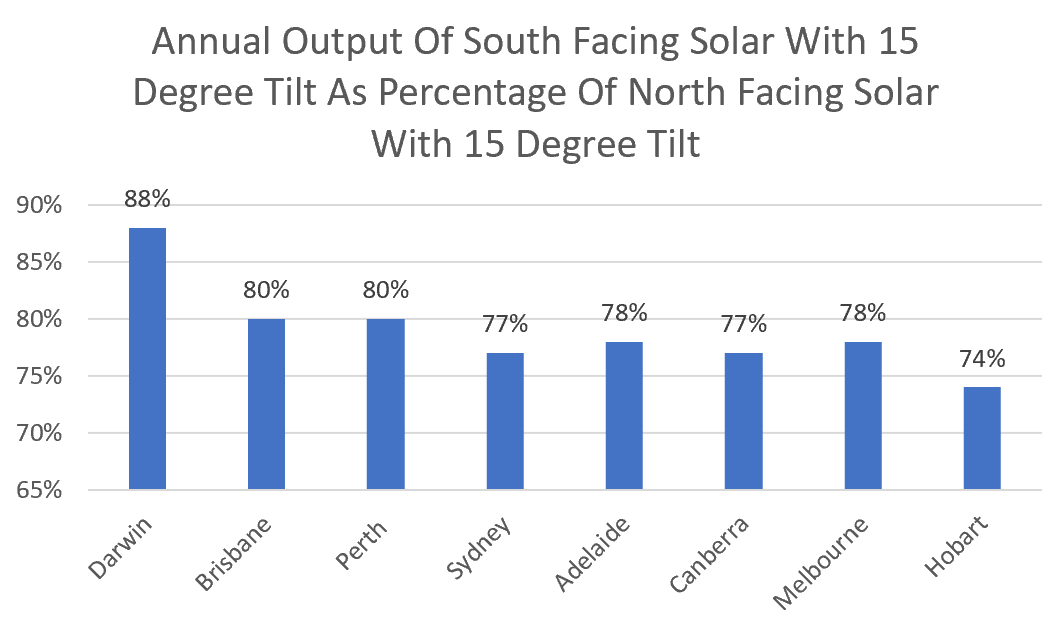

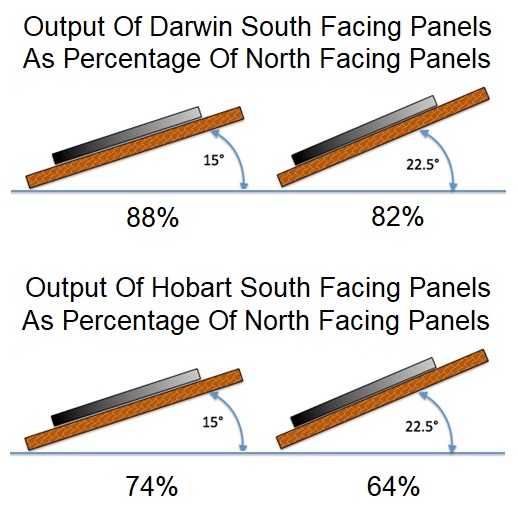
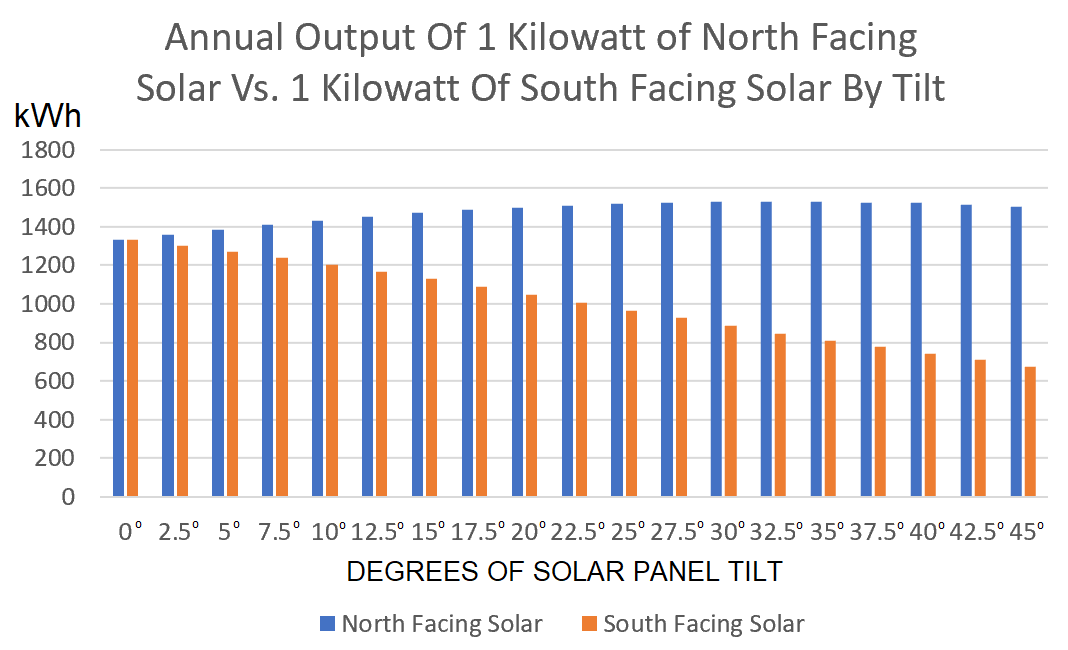
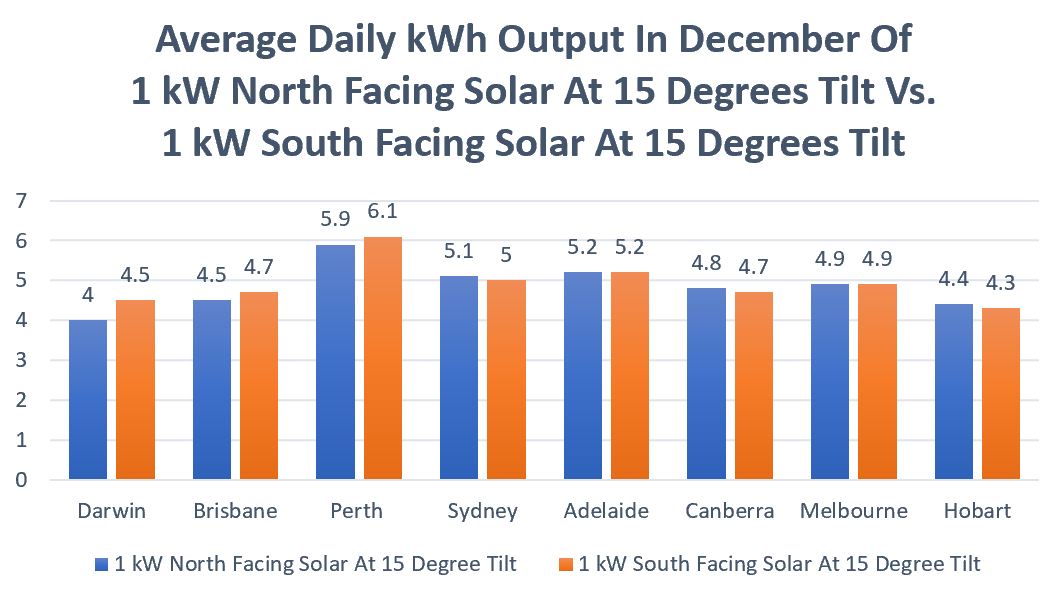
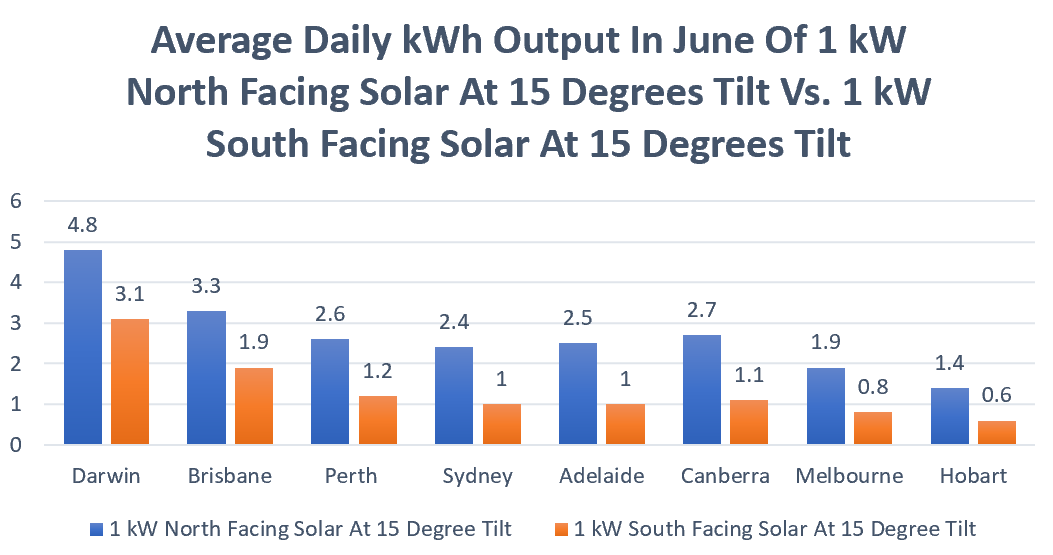
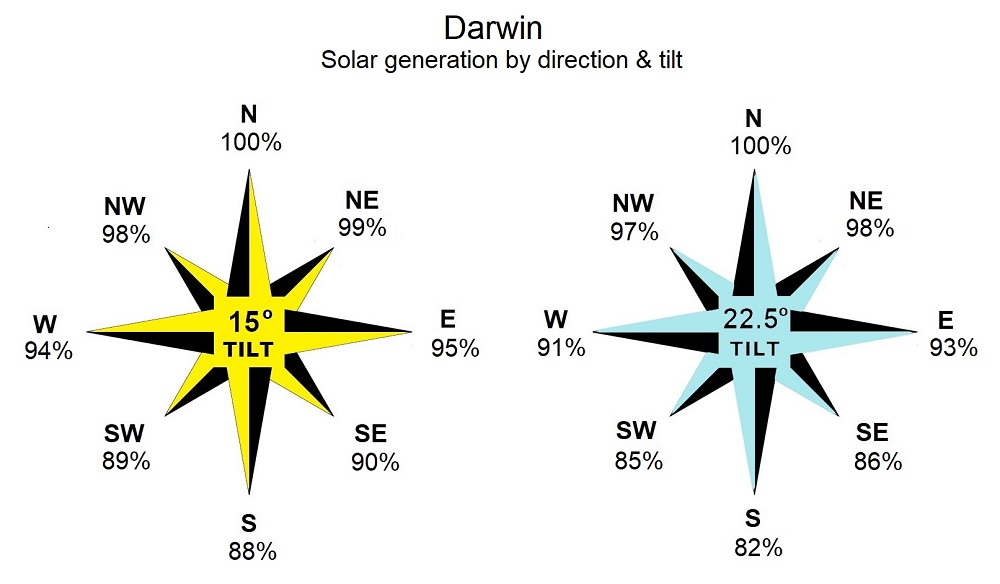
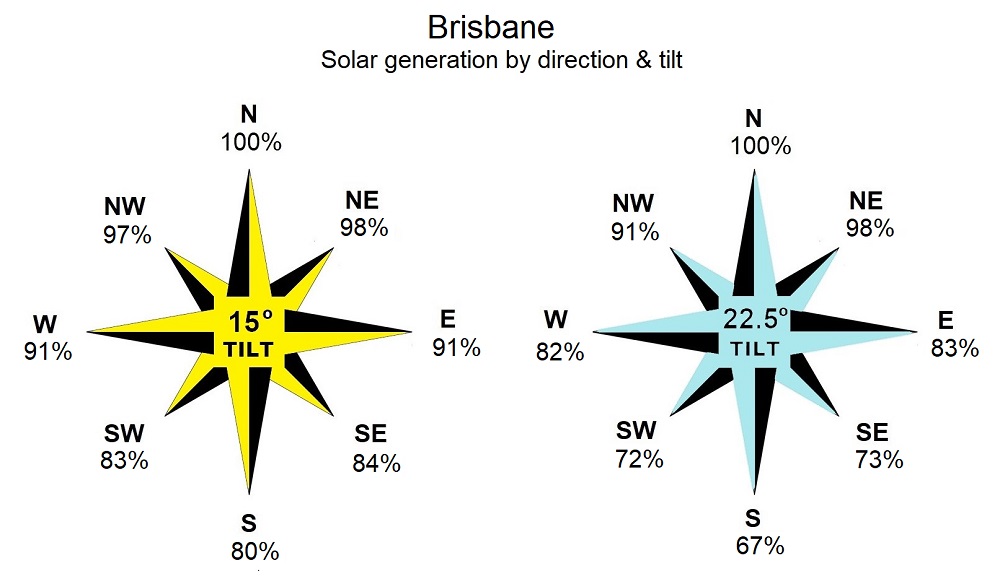
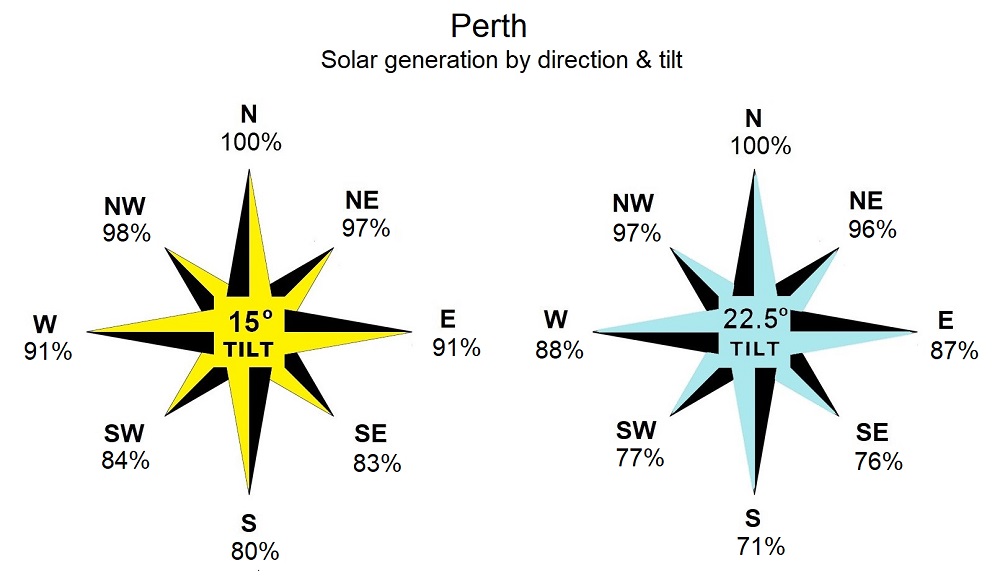
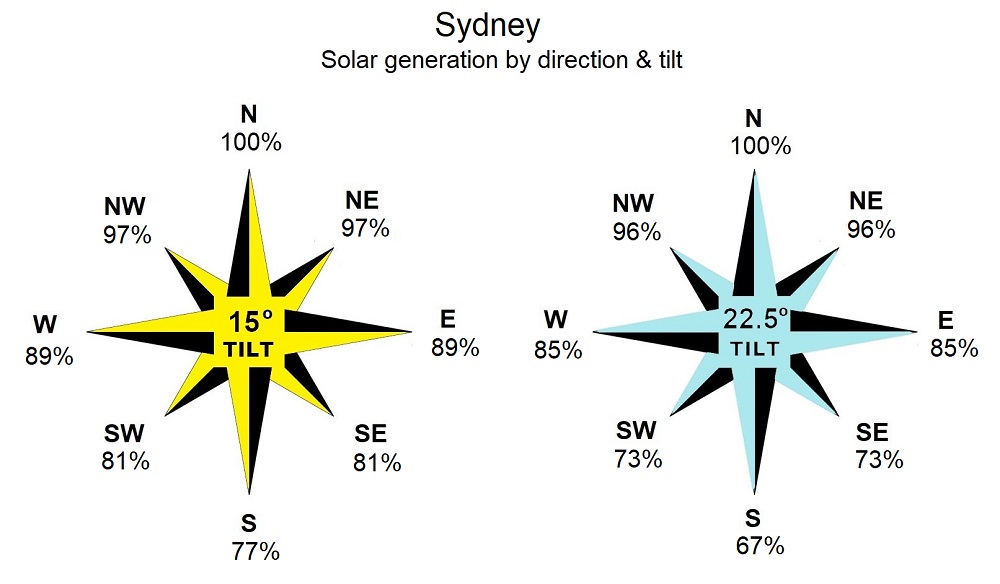
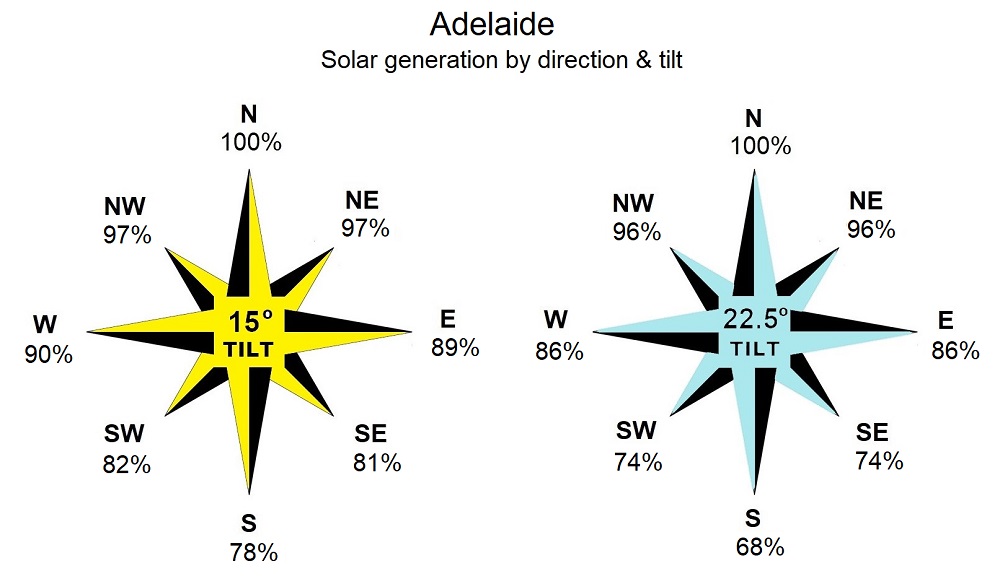
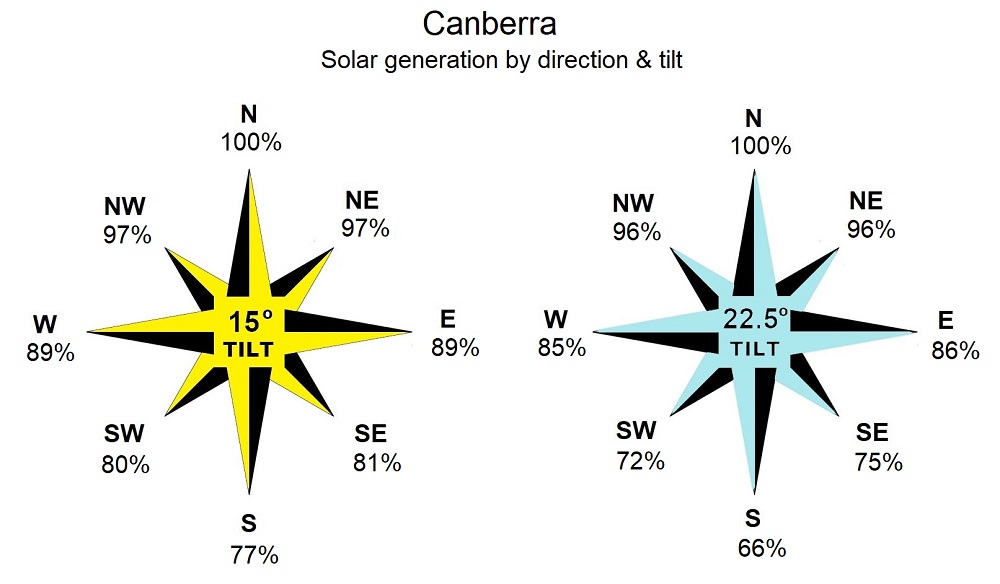
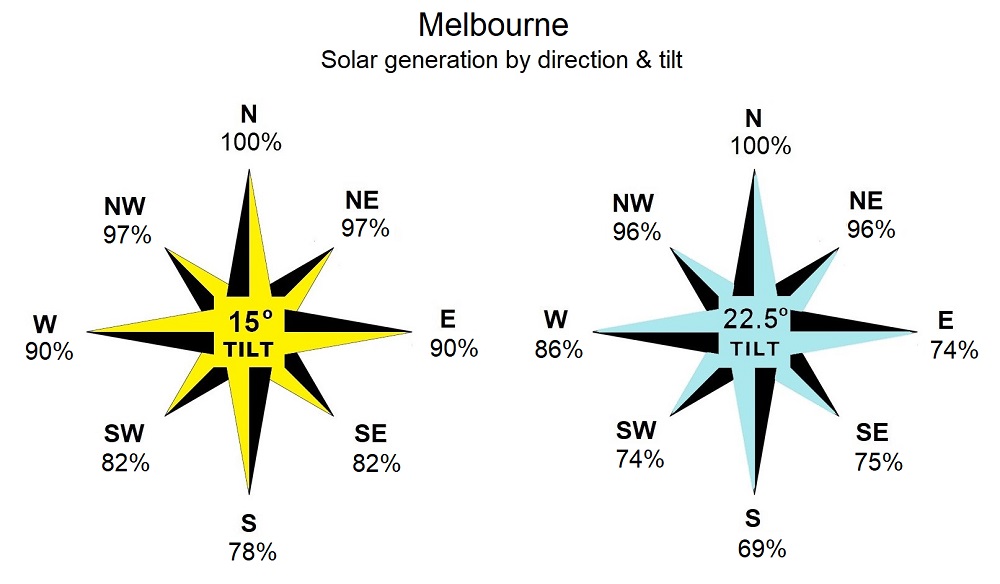
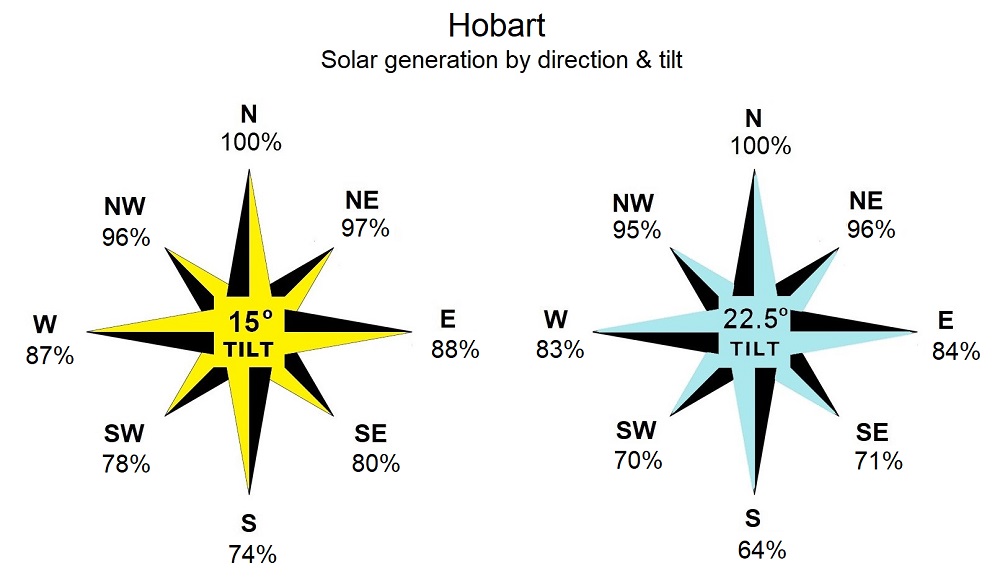
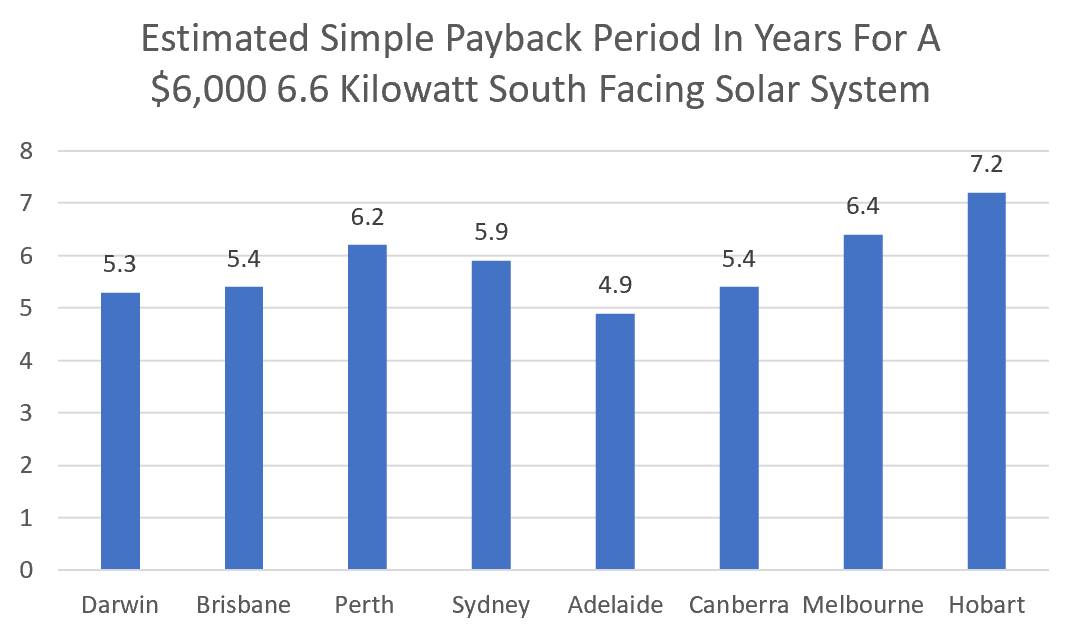
 RSS - Posts
RSS - Posts



Good stuff Ron , we moved some of our panels to face south and northwest. In summer in particular the south facing panels provide power well into the early evening offsetting g cooking loads plus any export after 3pm attracts a higher FIT. The NW panels extend the power generation period in winter and we sacrifice some power in the middle of the day when it is least usable.
Interesting….from one of Finn’s articles talking about East/West-facing panels: “In either case you’ll generally take a 10-15% power hit compared to having them facing the ideal direction (North).”
So with a roof pitch <7.5°, South-facing panels are roughly comparable to East or West?
In Sydney the annual output of 1 kilowatt of solar PV at 7.5 degrees in kilowatt-hours will be around:
North: 1,410
East: 1,326
West: 1,326
South: 1,238
So at that low angle east and west panels will produce about 8% less than north facing ones. At the more common roof slope of 15 degrees, west facing will produce 11% less than north facing ones. On a 22.5 degree slope roof west facing panels will produce 15% less. The exact amount will vary according to location.
Watch out for export caps. Maximum 5kw per phase. Large systems on single phase could mean that there is unusable capacity at times if you are not self using quite a lot. Therefore the cost of the incremental size may have a longer payback
What FiT does this piece assume? And is the 1 cent a year reduction down to a minimum of 6 cents per kWh a realistic assumption?
I had a look at FiTs the other month and quite a few only offer 5 cents per kWh (yes I’m aware Ronald has said they should rise), some offer as little as 3 cents per kWh, and while higher rates are offered, that’s often only for the first few kWh per day and then you get the bog standard rate. (AGL do offer higher rates but who wants to rip solar panels off their roof to meet plan conditions?)
A relative of mine on something like 18c per kWh FiT was decidedly unimpressed upon hearing this and double checked for himself!!! (Always best to double check what anyone else claims). Payback period calculations go completely down the toilet when the FiT halves or quarters overnight.
We’re both rather disappointed and reconsidering the value of solar investment. Certainly it’s not something we’d automatically recommend. Is it still worth it? Well …
Assuming either a $10,000 solar system or investing the cash and paying bills as they come, you’re looking at roughly $100 a year if in a 1% interest account. Are there better options out there? Sure, but it depends on the degree of risk you’re prepared to take.
A quick Duck suggests some super funds offered a return of about 30% for some options, but those are likely ultra high risk and your 30% increase one year could be a less than 30% of your capital remaining the next. Best case scenario though you’re looking at about a $3,000 return on your cash each year – ignoring the possibility of market crashes, or the fact your capital would shrink each quarter you pay your power bill. To be fair your interest would easily cover the cost of the bill, but super isn’t something can treat like a cheque account or a credit card. The point is investing $10,000 could net you a return of anywhere from $100 per year to $3,000 – discounting market crashes that consume your capital.
What of that $10,000 solar system? If, and this is all purely hypothetical, you exclusively export from a north facing 13 kW system at 5c per kWh, purchase slightly more than 5kWh per day at 23c per kWh (to power fridges, clocks, fans etc overnight), you’re looking at a repayment period of 10-15 years. Now if you have high consumption you can of course shrink that period – 33% self consumption translates to a 5 year payback period, except solar power isn’t stable so while you may generate several hours at your 10 kw inverter maximum one day, you may struggle to get half or a quarter the next when it’s rainy and\or cloudy meaning high imports not high consumption, which puts you back to paying for power and\or needing to export 5 kWh for every 1kWh you import. (Yes a battery would change this calculation – flatten the peaks and troughs, but that’s yet more invested in solar you need a RoI for).
In short, for an individual who is rarely at home and\or consumes minimal power, solar may very well be a poor investment now. For someone who uses a fair amount of electricity during daylight hours? Yes solar is likely a safe, stable albeit long term worthwhile investment for them, but only if they stay in the same house for a decade or so.
Is solar a worthwhile investment for the average Australian? Honestly I don’t know. For anyone planning on shifting in the next few years the answer has to be no. According to 2010 ABS data (yes it’s old) a quarter of Australians had lived in their place for 15 years or more, a third 5-14 years, and over 40% had moved in the last 5 years. Of that latter group, more than half had moved multiple times.
Odds are some (many?) here may disagree with my numbers. So without doing thesis level research, what data am I overlooking?
Over the past 100 years or so the Australian share market has averaged 6.5% real return. (In the US 6.4%.) But it’s very volatile. Rooftop solar can, depending on circumstances, can provide a return similar to this much more consistently. South facing solar will generally provide a worse return, but it’s still more consistent and also provides tax advantages over investing in shares or other investments. (A penny saved is worth more than a penny earned.) Whether or not it’s worthwhile will, as always, come down to individual preferences. If you are some sort of great investor you may not consider south facing solar worthwhile, but if that’s the case you can probably afford to spend a little to help save the planet in a way that also diversifies your portfolio.
George,
You miss the point why solar and wind power is here in the first place. To offset FF usage and carbon emissions by converting that energy into clean electricity. The secondary function is to save money on self consumption which has the biggest impact and reducing bills. Thirdly, exports for FiT ranks the lowest goal. Again, I repeat ad nauseam about people who complain about low FiTs, it’s because wholesale prices have come down. Yeah, people still scream I’m paying more for imports than exports. Again, that’s because of the other fixed regulatory distributor charges, GST, Environment/green energy schemes in the states, etc that are added to the wholesale price of electricity FiT will always be tied to wholesale prices, not retail prices. Retail prices are mark ups. That’s nature of a wholesale/distributor/retail system and that applies to any markets. The solar rebate at the sale of the PV is funded by the Renewable Energy scheme by the government, someone has to pay for that.
Having money in a bank would be a moot point if there is no habitable place to live in or to spend money on in a world that is increasingly ravaged by unbridled consumerism.
We need to get off the carbon economy and curtail FF usage. It’s no longer the fuel of choice in the 21st century. It might have been in the 19th/20th century when there were less people using the stuff then. Now that we are approaching 8billion people, it’s becoming a problem. We are literally destroying the planet. Not just climate change, but environmental damage and pollution.
Graham,
Actually FiTs are the primary thing that matter to plenty of folk investing in solar, with savings on self consumption a distant secondary goal since that’s dependent on usage and time of day. If you don’t use much power during the day you can’t save much that way. (Case in point, a guy I know via the internet bought up a lot of old panels, installed them in a field or something, and made himself a mini-solar farm. No FiT, no point).
Looking at the closest plan to what I presently have, FiTs have dropped roughly 10 cents per kWh, usage charges have dropped 1c per kWh and supply charges have dropped 5 cents per day. The fact wholesale prices have plummeted but retail prices haven’t really changed simply compounds the problem.
Concerns about living in an unhabitable world are the stuff of Hollywood. I have no problem with reasonable environmental (or health) action, the issue is that most of what’s suggested is neither reasonable nor effective.
Oh I fully agree about the stupidity of renovating a place only to sell it and have new owners gut the rennovation. That’s why when a relative’s place had to be put on the market it was given a clean but not a rennovation. A rennovated place in the same complex sold for slightly more, but rennovations would have cost vastly more making for a net loss on that effort.
Eventually solar will be expected on all houses? That seems unlikely to me. A majority? Sure, maybe, but definitely not all. Remember not all houses are on town water or sewerage and never will be.
Pointless to talk about whether solar is worthwhile? Of course you must. If you don’t then you’re assuming folk agree with you. Anyone who doesn’t will see things very differently since they don’t share your assumptions or beliefs. You say there’s a social benefit to reducing carbon emissions and fossil fuel benefits, but how much benefit do individuals within society perceive? As far as I can tell there’s zero benefit within my area so all that matters is the cost.
No I’m not after a medal for spending money on something worthwhile, but that’s the problem isn’t it, is it worthwhile? I selected a non-Chinese system because I believe that to be a worthwhile choice even though it entails spending more money. When I spend money I hope I can avoid companies who support genocide or slavery e.g. Xinjiang Province. I have various other causes and ethical concerns that affect my pass\buy decision making, but climate change and fossil fuels is absolutely not one of them.
You say we are spending too much time thinking about the money, not the benefits of renewable energy, the problem there is most of the benefits are subjective and geographically limited while the costs are absolute, nationwide, and prone to hurting those less able to afford it.
Perhaps I’m the lone skeptic crying in this digital wilderness, but from discussions elsewhere I know I’m not the only one around.
George Kaplan.
“Concerns about living in an unhabitable world are the stuff of Hollywood.”
And yet climate scientists are already observing detrimental and rapid changes in the biosphere. Compelling scientific evidence indicates:
1) At just +1.2 °C of warming, tipping points have been passed for several large Earth systems, including:
i) Rapid reductions in Arctic sea ice extent;
ii) Ice loss accelerating in West Antarctic Ice Sheet; and
iii) Large-scale die-offs of coral reefs, including in the Great Barrier Reef.
Others are beginning to tip, including:
a) Ice loss accelerating in Greenland Ice Sheet;
b) the Atlantic thermohalocline circulation (including the Gulf Stream) is slowing down; and
c) Ice loss accelerating in the East Antarctic region.
Noticeable changes are occurring in boreal forests; and thawing of permafrost.
2) System-level change is happening much faster than forecast.
3) Climate models don’t incorporate key processes being observed and are not reliable/adequate for modelling non-linear processes.
4) The whole Earth climate system is undergoing abrupt change. The Jet Steam destabilization combined with global warming is also bringing new extremes over Europe, Asia and North America, including unprecedented heat, wildfires, rains and floods.
5) Cascades and accelerated warming may trigger Hothouse conditions.
6) Risks have been underestimated.
7) Decarbonisation is not enough. Reducing the level of atmospheric CO2 by carbon drawdown is vital, but the drawdown impact is relatively slow.
http://www.climatecodered.org/2022/02/have-tipping-points-already-been-passed.html
There were many Australians who experienced first-hand the horrors of the continent-wide 2019-20 bushfires. That was no Hollywood movie.
https://www.9news.com.au/national/australian-bushfires-black-summer-one-year-anniversary/4b61f48a-9b80-44b8-8f35-a57249f924ab
I think you are living in denial, George.
You can make the same argument about people who do renovations and then move on. They don’t stay long enough to enjoy the benefits of the renovations. I know of people who spent thousands on bathrooms and kitches, only to sell and move on. And who knows what the new owners will do? Rip it out and put their own reno in.
As more people put solar on rooftops, the odds of buying/renting a house fitted with solar PV increases and eventually it would be expected that all houses, where possible, will have solar PV fitted just as much we expect water and sewerage to be connected. There was a time in Sydney itself (and still is) that outhouses are still in use (you know outdoor toilets, not indoor)…..
I think it’s pointless to talk about whether it’s worthwhile. Of course it is. There’s a social benefit for all – reduction of carbon emissions and pollution from FF use. Do you want a medal for spending money on something that benefits society as a whole? Because that’s how you come across.
We are thinking too much about the $$$, not the benefits of renewable energy.
Amen
There is only one thing that you completely wrong.
Brisbane does NOT have lots of birds that want to kill you. We love our birds here in Brissie, and they’re super friendly. Magpies (and others) say hello to us every morning, absolutely fabulous. When I’m mowing they’re so friendly that they get too close to the mower, so I often have to slow down to avoid risking hurting them.
Apart from that, LOL :-), great article. Thanks ?
Okay, I’ll qualify that to “Brisbane has lots of birds that want to kill me.” This includes magpies, razor winged plovers, tripping over bin chickens, expired chicken, and confused emus.
My reply to George Kaplan.
Investing what to most is a significant amount of $ in a roof-top solar PV system that will be on the roof for maybe 30 years is a long term decision.
Which suggests it could be advisable to think ahead a bit, not just use your expected next annual power bill as pretty much the sole basis for evaluating both your personal economic benefits, along with it’s associated implied adoption of a very short time horizon.for the continuation of those benefits.
A person’s personal circumstances today are unlikely to be the same in (say) 5 years time, let alone 10 in years time. eg the two or three teenage kids at home with you today are perhaps unlikely to still be living with you in the short to medium term future. That’s just one likelihood, out of a vast range of possible others.
Mingling with those are other quite significant and much wider possibilities.
For example, here’s a recent news headline regarding an “unprecedented” level of avalanches in Austria during the current skiing season
https://www.independent.co.uk/news/world/europe/austria-avalanche-deaths-snow-weather-b2009304.html
Over in Alaska, there’s a similar situation.
Some current Alaskan news headlines are:
https://www.adn.com/alaska-news/weather/2022/01/21/dangerous-avalanche-conditions-expected-this-weekend-as-temperatures-rise-in-southcentral-alaska/
https://www.adn.com/outdoors-adventure/2022/01/30/avalanche-danger-at-turnagain-pass-will-continue-following-weekend-slides/
and here’s today’s headline news from our national broadcaster ABC
https://www.abc.net.au/news/2022-02-08/losses-unclear-as-wheatbelt-communities-face-devastating-fires/100809984
To get to the point, and not digress into the climate change related generalizations that most are already familiar with, it seemed quite clear to me a few years ago that having more air-conditioning capability would very likely be far more desirable to have, rather than none or little. So i took that into account when purchasing my PV system.
What that did of course was increase my ‘self-consumption’. And, generally speaking, increasing your self-consumption has become even more valuable over time as FIT’s declined.
But there is something else that happens along the way. You quickly learn that if you make some relatively simple and quite mundane ‘life-style’ changes, you can boost your self-consumption benefit significantly, compared to what it was before you made those changes.
Life-style changes can also be made in other areas of your life too.
So my general reply to George Kaplan is “So what? – a potential future decline in FIT rates was seen as being quite probable by many who purchased their PV system some years ago”.
There’s also some other social trends that are emerging…
1) There’s a growing trend among home-owners to ‘stay put’.
That’s also being reinforced by changes in ATO rules regarding the length of time you need to stay in a residence in order for it to be classified as being your ‘primary place of residence’. : see –
https://www.ato.gov.au/Individuals/Capital-gains-tax/Property-and-capital-gains-tax/Your-main-residence-(home)/?=Redirected_URL
Adding to that though is the fact that more and more people seem to be realising that there are significant tangible and intangible benefits to staying put where they are for longer.
There’s less disruption to your child’s schooling and social interactions, moving expenses are significant, for dual income families one of the partners may lose their employment, a risk that the new job may not result in the overall benefits you thought existed, higher marginal rates of tax on higher income reduce the net cash gain you get. All those kinds of things are factors too..
2. A slow but steady growing general public realisation that it might be a very good idea to reduce your ‘buying on impulse’ habits.
“Saving for a rainy day” has always been good advice, even if you don’t know whether or not all you’ll get just a few brief showers or extreme tempest conditions complete with intermittent tornadoes in the future.
3. A common complaint is that solar pv system owners are getting ‘unfairly’ benefited compared to non-home owners. What’s left out of that complaint is the fact that many of today’s home-owners were once renters themselves, and made conscious financial choices as to what they spent their money on during their early adulthood period, or even from their early teens in order to purchase a home.
That said, there is a genuine problem these days. There are people in society who are disadvantaged in one way or another through mostly no fault of their own, and who genuinely need help in paying their electricity bills. Those people do get some assistance from State governments in meeting their electricity bills,
However electricity bills are just one aspect of a wider problem of inability to meet ALL their bills, including the basics of food and shelter along with a refusal by Federal government to fully index pension and assistance levels in line with inflation.
Existing home-owners with roof-top solar aren’t the fundamental cause of the problem of ‘high electricity bills’ though.. Mostly, some politicians did, and a number of opinion polls suggest that the overall public perception of our current politicians and the policies they’ve chosen to adopt falls far short of being flattering. .
.
. .
Shallow tilt angle panels and even South facing panels perform well under cloudy skies.
I see so many installations that go to ridiculous lengths to follow the ancient dictum – face due North at latitude tilt.
Even to the extent of fitting legs for an additional 10 degree tilt and skewing panels by 10 degrees to follow the rule.
My takeaway from this for people deciding on new roofing/tilt frames trying to maximise solar output is:
1. East-West almost always slightly beats north-south at the common roof angles shown above (the exception is for steep roofing in places such as Melbourne and Brisbane where east facing panels are comparatively weak).
2. A gable produces more than a hip on the south side of a building.
3. A hip produces more than a gable on the north side of the building (solar installation costs may be higher for a hip (?), in an often low feed-in tariff and low self-consumption part of the day).
Ronald you forgot that people are basically lazy and won’t clean panels that are pitched at less than ten degrees… north south east or west
Dust and dirt accumulate and do not self clean with rain. In my experience this leads to long term yield loss .
That’s a good point about dirt on low tilt panels. I will add a footnote pointing out the problem.
I have flat panels on my caravan (around 1kW in total).
In good weather we do everything including hot water on electricity, don’t even turn the LPG gas bottle on.
However the downside is that they get absolutely filthy being flat.
I have to clean them very often.
A caravan is worse location for dirt than a roof but, no matter where they are, flat panels can definitely get very dirty. I’m actually writing about flat panels now, so there will be a bit more on the blog about them soon.
I picked this line out as most interesting: “it usually makes more financial sense to install panels parallel with the roof than pay for tilt racks1. ” I know you are talking here about South facing solar in Oz. I am wondering if this is true of North facing solar as well? Seems like it would be. I am in California, I have a backyard rack of solar, but thinking about mounting more on my roof as they dang trees keep growing up around my solar. The cost to cut trees is way more than the electricity they block, so looking for a cheaper fix. Maybe flat solar on the roof? Thanks for all your good work. Always a clear analysis. I have “flat panels” on my van for power while camping, works better than tilting.
Dennis, costs of solar PV systems and the net metering arrangements in California are vastly different to those in Australia. Almost none of what Ronald has written (in terms of the numbers) applies there, although the basic process of assessing it would be the same. You would have to do the sums for your own situation.
Hi dennis. You can maximise the efficiency of a North facing roof in the northern hemisphere by having all the panels parallel to the roof except the last row near the edge, place those on tilt frames like I have on my property. Try to have those frames tilted at the same degree from horizontal as thout latitude north. This way they are as good as on your south facing roof without the rest of the panels shading them. Hope this helps with your tree issue.
Denis,
I don’t know how they ‘attach/fix” solar panels to the roof of a van in the USA, but here, a common practice is to glue them to the roof, rather than have rods that are attached by drilling through the roof, and adding bars to the interior top of the roof.
A similar process is often used with caravans.
Because the solar panels tend to be smaller than household ones, and also in order to reduce overall weight of the vehicle or caravan, it initially
seems a good idea.
However, because of weather exposure and in the Australian case the extreme temperatures you can get, the glues have been known to gradually ‘break-down’ over time. So you can get instances of a panel flying off the roof, to the detriment of anyone who’s following you.
There’s a few added factors, such as the fact that the vehicle roof might be slightly curved which can add a degree of ‘ upward suction’ to the top surface of the panel, just as it does to aeroplane wings
Anyway, here’s an article about it, along with photo/web-cam of what I’ve described.
https://rvdaily.com.au/flying-solar-panels-the-danger-lurking-on-your-rvs-roof/
Thanks for your response Des Scahill. My van has 2 flexible solar panels glued to the roof and I added two more that screwed to mounts in another location. So far, no loosening of the glue has happened since 2018!
I couldn’t say for California, I’m afraid.
Why is Melbourne placed better than Sydney in your first graph? Surely Sydney being closer to the equator than Melbourne would give a higher percentage?
Other factors than you have stated that made me use a heap of my south facing roof is the time of day that I have electricity demand from the house. I get up early (flicking switches on and running machines) and the sun is around at azimuth 120 as it is rising in the middle of Summer. South and east facing panels are more efficient at that time. Same goes for end of the day, south and west panels perform best.
I have a 22 KWI with 27 KWP, the majority facing North but with a good proportion facing south, west and north east. The North east are at 45 degrees pitch to access early Winter rays Azimuth 60 for my latitude south (in line with Sydney)
Compared to the output of a north facing panel, a south facing panel in Melbourne performs better mainly because Sydney is cloudier than Sydney. This results in more periods of indirect sunlight where there is less difference between the output of north and south facing panels thanks to the scattering of light by clouds. Annual output per kilowatt of PV will be higher in Sydney, whether it faces north or south.
Kel Wellington says:
February 12, 2022
Ron, A good write-up. Since I already have a south-facing array I was hoping your discussion would extend to a few other aspects:
1. My roof being southerly, I thought to offset this by increasing the size. I got a good deal on 10.5kW of 400W Jinko panels with an 8kW Sungrow inverter. However, although my Smart meter is limiting the exports to 5kW with a pitiful 3.5c/kW FiT I find that in Qland I can’t have a Tesla Powerwall 2 battery as it exceeds some rule on total inverter size!?! – unless I go to two phase (which is not an option).
The only way I can find to circumvent this is to cancel my FiT. Can you explain the reasoning behind this?
2. My aircon uses solar power during the day but lots of my usage is with induction cooking, etc in the evening. To do this without grid power I need a battery. Many years ago, Germany cancelled its solar subsidies and moved them to a battery subsidy. In Oz Sth Aust. seems to be doing this via DER forming a VPP. Would it not be a good idea to have this or microgrids in the Eastern States?
3. I’m also ex-CSIRO and an elec. engineer now concerned at the need to make the World’s energy sources renewable and electric. So, I’ve had a Tesla 3 EV for a couple of years and can recommend it from many perspectives. It saves me about $4000/yr and Matt Kean (NSW treasurer) set subsidies so that the base model starts at about $58,000.
Charging without solar can be done with Powershop between midnight and 0400 for 6.7c/kWh. So I fill the 550km tank for $5 instead of $90 for a fossil fuel car. I now have a Raspberry Pi microcomputer setup to charge the car during the day at a rate depending on the output from my Sungrow inverter. I hope to add the future battery to this charging circuit. Have you done any work like this ie to offset the variability of the inverter output “when the sun don’t shine” (– Morrison)?
I know where you’re coming from.
This insane limit on inverter capacity is totally crazy- it counts the size of your solar inverter AND the inverter in the Powerwall for a 10kW “house” limit- even with a 5kW grid feed in limit in place. I’d love someone to explain the logic there!
It’s stopping a few people I know from getting a Powerwall, including one of my sons, totally crazy.
Surely we need to do everything possible to get batteries into homes and reduce that evening peak.
As usual, the authorities are way behind the eight ball and living in the past, instead of looking to the future.
We’re in the same boat- it’s prohibitive to move to 3 phase power. Although we’re currently on the old premium FIT and can change nothing, when that expires I’d love to fit a LOT more solar AND a Powerwall, but we will run in to the same inverter size limit problem.
Agree re your Model 3- our’s is very nearly 2 and a half years old and has been nothing short of fabulous. (Where has that time gone?)
Ronald, I came across your article today as I am pondering the leveraging my south roof aspect.
My forever home faces west and i have 1.665Kw SunTech-Bristile 45w solar tiles (1.5kw Fronius Galvo inverter) to preserve the street appeal In addition to 8.4Kw (7.35Kw North and 1.05Kw East) LG Neon2 350w panels with Enphase IQ7+ micro inverters. I think this is rated at 10.Kw total connected to the grid by 3phase.
I use SolarAnalytics to combine and track generation of both systems and usage across 12 channels.
My question is about adding LG panels and Enphase microinverters to the south roof aspect. Interestingly the sun rises and sets on the south side of my west facing Sydney home during summer!
As a result, and from reading your article I feel I can capitalise on the South roof aspect.
This brings 3 questions to mind on some of the content and comments above.
1. Would adding panels to the south aspect break the Max rated capacity for solar connection to the grid? ie breaching a threshold imposed by the wholesale electricity provider? (im aware that Origin must not be larger than 10kW on their Solar Boost+ plan, or have a daily feed in limit of 14kWh on some plans)
2. Are you aware of any reports accounting for the roof shading benefit of having solar panels
3. Given some plans revert the to the standard FIT rate after 14kWh like Origin, does a battery then gain momentum.
For reference, over 12m my current systems exported 9.08 MWh back to the grid, imported 6.33 MWh, and self consumed 5.30 MWh. Solar Analytics recommend a 17KwH to reduce my Grid usage by 76.45 %
My highest Daily generation is 66kWh with this system.
Keen for your and others thoughts on my questions.
Hi Gavin.
1. The good news is – whether you are in Sydney’s Endeavour or Ausgrid network areas – if you have three-phase power you can have up to 30 kilowatts of inverter capacity and export all the surplus solar energy generated.
2. I looked into the difference between putting solar panels on a roof and using heat reflective paint here…
https://www.solarquotes.com.au/blog/solar-air-conditioning-vs-heat-reflective-paint/
…and solar panels came out well ahead. Note I didn’t have a lot of hard information to draw on for that article, but I think the conclusion is pretty clear.
3. More solar makes a battery more viable, as you are more likely to be able to fully charge it even if the weather is poor. However, a home battery isn’t likely to pay for itself yet. But if you want one anyway or place a high value on silent, clean, backup power, then higher electricity prices and lower feed-in tariffs definitely make batteries more financially viable than they were.
Note that LG is no longer making solar panels. If you are planning to use old stock that should be fine, as they are very reliable panels and I’m confident LG will continue to provide warranty support if there is a problem.
Thank you Ronald
I’ve spent hours trying work out if it was worth putting panels on my south facing roof. Partly because I was researching solstice sun angles instead of just asking the question. I’m only just learning about solar panels.
Your acritical has answered all my questions and more.
Thanks again
I would appreciate your advice on a thought I have.
My almost perfectly south facing roof in Kiama NSW is @ 25 deg pitch.
I don’t want to put them on a tilt rack because they are so ugly.
My idea
Can I get panels approximately 300mm wide X any length eg 2M? The only type I found on line are for camping.
With this I can make angle brackets so the panels are tilted enough so I don’t get shadows from other panel during the winter solstice.
Because they are much smaller and there will be a few rows I think this will be more aesthetically pleasing.
I relies it will be a more expensive option and without knowing pricing I hope it just means a extra couple of years to pay it off
Hi David.
There are some manufacturers that produce small panels. You may be able to find some of the right size and have them installed — possibly with several attached to one microinverter. But I don’t think it will be worth it. I don’t know of any panels of that size suitable for rooftop installation. It’s possible none exist that you can get STCs for that lower the cost of solar. Also, unless an installer has had experience in this sort of thing, they are unlikely to be interested in doing the research to find out if they are available and working out how to wire them up so they can be used. If it is possible to use standard panels, they will almost certainly be a better solution, even if they suffer shading and even if that shading affects the panel warranty.
Sorry I couldn’t give you better news.
UPDATE: Actually, now I think about it, there are some Building Integrated PV (BIPV) tiles that are long and thin and may be suitable for what you want to do. But note these won’t be cheap and suppliers may not be interested in supplying less than what’s required for a typical installation.
Again thanks very much for you time and advice.
I will look into the Building Integrated PV (BIPV) tiles
David
A much better article than some of your colleagues.
Considered, measured and most importantly lacks the zealatory.